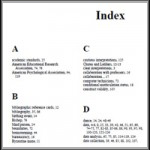
If you have finished writing your book then you should be willing to create an index for it. The back-of-book index is a main component of any successful book. Creating the book index yourself is not hard if you know the rules and steps you should follow to accomplish it in a professional way.
I will mention 10 important tips you should know before starting your index.
The main target of those tips is to know where to start from when creating the book index. They will also help you create a clear index that is not confusing for your book readers, so they can access the information they are looking for easily and in seconds.
- When should i start creating my book index? You should wait till your book typescript and proof stage is done because you need to have your pages numbers ready and final as you do not want to enter wrong pages numbers in the index.
- Check other similar indexes: Check indexes of a number of books similar in topic to your book, and write their positive & negative points before creating your book index to consider them when creating your book index.
- Concentrate on your book main subject: When you start creating your Index it is not a good thing to put all words of your book in that Index. That will make it hard for the book reader to use your Index when it is very long. Think like a reader, make your Index simple and shortened.
Before start creating your Index write 10 to 20 most important subjects your book is talking about, then when you select your Index words check if each word is related to one of those subjects or not. If not then skip it. Mostly the reader will not need to look for that word in the Index.
- The index size: Your Index should not be > 5% of the number of pages of your book. When you collect the entries of your index, you might be confused if what you are collecting is many or low, so do not omit any entry in your initial index. When you finish your initial index you can then start removing the least important ones if you find the index big. That will make your job easier.
- Number of columns per page in the index:
 Most books write 2 columns per page in the index section. This is the best option for a good readable index, especially if some index entries are long, but if most of your index entries have 2 or 3 words only then you can write 3 columns per page. That will save a lot of space, and you can have more index entries that way because you are having an extra column of index entries per each page. But still; 2 columns is a better option.
Most books write 2 columns per page in the index section. This is the best option for a good readable index, especially if some index entries are long, but if most of your index entries have 2 or 3 words only then you can write 3 columns per page. That will save a lot of space, and you can have more index entries that way because you are having an extra column of index entries per each page. But still; 2 columns is a better option.
- Use ranges of pages instead of individual pages numbers: It is always better to use pages ranges like 23-29 instead of individual pages numbers 23, 24, 25, 26, 27, 28, 29.
- Use Headers & Sub-Headers in your index: It is a good idea to use indented entries (Headers & Sub-Headers) in the index, as the indented entries are much efficient and useful to readers. They make the index tidy and well arranged. Ex:
Water supply, 35–50chlorination, 45
emergencies, 47
filtration systems, 36–38
pump use, 35–37
testing quality, 46
If you do not use indented entries then those entries would appear like this:
Water supply, 35–50: chlorination, 45; emergencies, 47; filtration systems, 36–38; pump use, 35-37; testing quality, 46;
As you can see above; your index will not be read friendly if you did not use headers and sub-headers.
- Use cross-references: Always use cross-references whenever possible. Cross-references are a way of referring the index reader to other index entries he might be interested in. You do this using a prefix like “see” or “see also”, ex:
Internet marketing, 28-47; See also Advertising; Customer service; E-mail; Events and meetings; Fulfillment; Lead generation
So if a reader is looking for “Internet marketing” in the index, he might also be interested in other topics in the index related to it. May be he will find the answer he is looking for in those other topics.
- Do not write many pages numbers for each word:
Try to write only the most important pages numbers for each index entry it is found in inside the book. The reader expects this, and it will save him a lot of time. For example this is a good index entry:
While this is a bad one:
Roman army, 2, 66, 159-160
Roman army, 2, 26, 30-31, 34-36, 39-40, 42-43, 45-46, 49, 51, 53-64, 66, 73, 81, 84-93, 95, 101-102, 106-108, 111, 115-116, 118, 120-121, 128-129, 131-133, 143-146, 149, 152-153, 157, 159-160, 162, 166-167, 169, 173, 175, 177-179, 182, 185, 188-191, 194-195, 198, 200-202, 220-222, 225, 231, 234, 241, 249, 253-255, 257-262
- Write the index entries as hyperlinks: It would be helpful to write the index entries and their pages numbers as links if you are creating a digital copy of your book (PDF or Document file). When a reader clicks on a page number for an index entry it would take him directly to the page number where this entry exists, so he won’t need to scroll all the way up manually.
I hope those 10 tips will give you a good start for your index. In the upcoming posts I will write more detailed points to help you understand indexing rules much better. Good luck with your index 🙂



